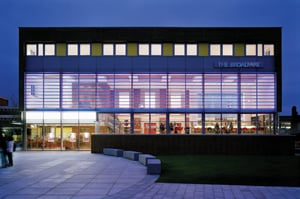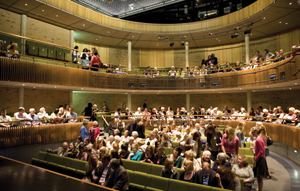Designed to be different
Tim Foster offers a theatre architect’s view of the process of designing and building spaces for performance


I have spent most of my professional career involved in the design of theatres and other types of performance venues, and the greatest rewards and challenges of this work lie in the fact that no two clients or projects are alike. My practice works with major commercial theatre owners and operators, independent companies in the subsidised sector, community and educational organisations, local authority owned venues and small start-up companies who have little money or experience but ambition and determination in spades. It is this variety which makes the work so fascinating. A theatre is rarely a purely commercial enterprise, unlike some other building types. They tend to be looking for a bespoke solution to a particular set of needs, which frequently change as the project develops. This may be the design of an entirely new venue, the reinvention or restoration of an existing one, or the creation of a new performance space within a building designed for another purpose.
Design and construction is only part of the process. Funding is always hard won and the architect often has to play a role in helping the client to raise funds. Most projects are made possible by funding from a range of sources, and the process of assembling this often produces complications in reconciling the demands and timescales of multiple funders. Aligning these, and building the necessary financial and political support, takes time, which is frequently underestimated at the outset.
The client’s relationship with their architect and the rest of the design team is a crucial one. It is therefore important to adopt a process for selecting the design team which ensures they have the right skills and experience, and are compatible with the client and their aspirations. Most publicly funded projects will require a competitive selection process, which is transparent and auditable, and care is needed to structure this correctly. I always encourage potential clients to carry out this process at an early stage to avoid the disruptive effects of a change of design team mid-project, with all the loss of mutual understanding that entails. It is better to select an architect you feel you can work with rather than a design. Design competitions have the effect of forcing the client to choose a superficially appealing proposal, which freezes the design too early before the brief or dialogue with the architect has had time to mature. Do not fall into the trap of selecting your team purely on cost grounds. The right architect for the job will save you money in the long term and the selection criteria can be structured to allow for an appropriate balance between cost and quality. Take the time to research your prospective architects carefully by visiting their buildings and their offices and talking to previous clients – it’s surprising how few clients do. You may need the help of a project manager to organise the mechanics of the selection process but make sure you lead them to the conclusion you want rather than the other way round. Many project managers are process-led and have little or no experience of how theatres work.
Developing a realistic design brief, which reflects both the needs and budget of the client, is essential before the design process begins. It is usually best if this is done in conjunction with the architect and their team, rather than before they are appointed. I have lost count of the number of design briefs I have received in which there is such an obvious misalignment between the accommodation required and the budget, that one knows the project is in trouble before it has even started. It is worth involving an experienced quantity surveyor who has real knowledge of what theatres of different types cost at an early stage to avoid this problem. Ideally, the brief will be developed in close consultation with the end users and the wider community but this is not always possible. Where there is an existing company, who know what they want and who already have a developed artistic vision, it is much easier but there are cases, such as when a local authority decides to build a new venue, where there is no artistic management in place. In this situation it may be necessary to hire consultants to help develop a viable business model, which will in turn inform the brief. Try to avoid writing a brief which is over-prescriptive and tells the designers what the solution is before the options have been fully explored. A more open-ended approach, which defines aims and objectives but leaves the solution open to interpretation, will usually evoke a more creative response from your designers. This is where the training and imagination of a good architect can bring real added value.
I realise that most of what I have written so far is about how to lay the foundations of a project and while I cannot overemphasise how important this is to its ultimate success, let us not forget the value of good design in creating a building which is both practical and inspirational. A successful theatre must have at its heart an auditorium which will provide creative impetus to the artists who will work in it; it must have the best possible facilities for audiences, front-of-house and artists, technicians and management backstage; and it must have an identity in the townscape which will make the public want to come inside. I would argue that only an experienced theatre architect has the skills to fulfil all these requirements and to create a building which is both memorable and fit for purpose.
Join the Discussion
You must be logged in to post a comment.